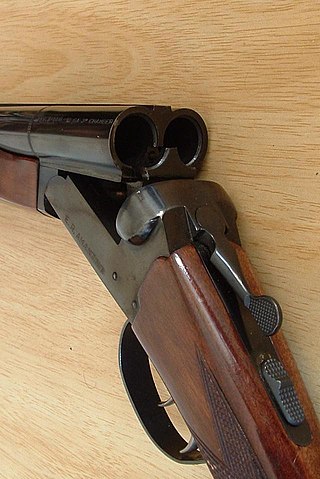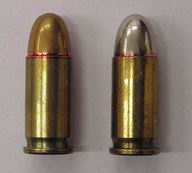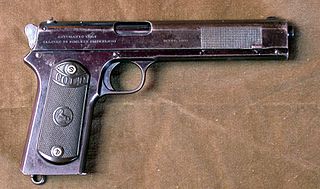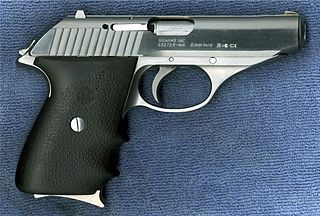
In firearms terminology, an action is the functional mechanism of a breech-loading firearm that handles the ammunition cartridges, or the method by which that mechanism works. Actions are technically not present on muzzleloaders, as all those are single-shot firearms with a closed off breech with the powder and projectile manually loaded from the muzzle. Instead, the muzzleloader ignition mechanism is referred to as the lock.

John Moses Browning was an American firearm designer who developed many varieties of military and civilian firearms, cartridges, and gun mechanisms – many of which are still in use around the world. He made his first firearm at age 13 in his father's gun shop and was awarded the first of his 128 firearm patents on October 7, 1879, at the age of 24. He is regarded as one of the most successful firearms designers of the 19th and 20th centuries and pioneered the development of modern repeating, semi-automatic, and automatic firearms.

A derringer is a small handgun that is neither a revolver, semi-automatic pistol, nor machine pistol. It is not to be confused with mini-revolvers or pocket pistols, although some later derringers were manufactured with the pepperbox configuration. The modern derringer is often multi-barreled, and is generally the smallest usable handgun of any given caliber and barrel length due to the lack of a moving action, which takes up more space behind the barrel. It is frequently used by women because it is easily concealable in a purse or a stocking.

A semi-automatic pistol is a handgun that automatically ejects and loads cartridges in its chamber after every shot fired. Only one round of ammunition is fired each time the trigger is pulled, as the pistol's fire control group disconnects the trigger mechanism from the firing pin/striker until the trigger has been released and reset.

The Beretta Cheetah, also known by its original model name of "Series 81", or "80 Series", is a line of compact blowback operated semi-automatic pistols designed and manufactured by Beretta of Italy. They were introduced in 1976 and include models in .32 ACP, .380 ACP and .22 LR. Production paused in 2017, but Beretta revived the marque in 2023 with the release of the 80X.

The Beretta 21A Bobcat is a semi-automatic pocket pistol designed by Beretta in Italy. Production began in the late 1984, solely in the Beretta U.S.A. facility in Accokeek, Maryland. It is a further development of the Beretta Model 20, whose production ended in 1985.

The Beretta 950 is a semi-automatic pistol designed and manufactured by Beretta since 1952. It builds on a long line of small and compact pocket pistols manufactured by Beretta for self-defense. It was intended to be a very simple and reliable pocket pistol.

.32 ACP is a centerfire pistol cartridge. It is a semi-rimmed, straight-walled cartridge developed by firearms designer John Browning, initially for use in the FN M1900 semi-automatic pistol. It was introduced in 1899 by Fabrique Nationale, and is also known as the 7.65×17mmSR Browning or 7.65 mm Browning Short.

The Thunder 380 is a lightweight, relatively small semi-automatic pistol series chambered in the .380 ACP caliber made by Argentine firearms manufacturer Bersa, S.A.

The Heckler & KochP7 is a German 9×19mm semi-automatic pistol designed by Helmut Weldle and produced from 1979 to 2008 by Heckler & Koch GmbH (H&K). The P7M13, a variant of the P7 with a double-stack magazine, was produced until 2000.

In American English, a pocket pistol is any small, pocket-sized semi-automatic pistol, and is suitable for concealed carry in a pocket or similar space.

The Sauer 38H or often just H was a small semi-automatic pistol made in Nazi Germany from 1938 until just after the end of World War II by J. P. Sauer & Sohn, then based in Suhl, Germany. The "H" in the model number is short for "hahn", referring to the internal hammer of the firing mechanism.

The Colt Model 1903 Pocket Hammerless is a .32 ACP caliber, self-loading, semi-automatic pistol designed by John Browning and built by Colt Patent Firearms Manufacturing Company of Hartford, Connecticut. The Colt Model 1908 Pocket Hammerless is a variant introduced five years later in .380 ACP caliber. Despite the title "hammerless", the Model 1903 does have a hammer. The hammer is covered and hidden from view under the rear of the slide, this allows the pistol to be carried in and withdrawn from a pocket quickly and smoothly without snagging.

The Colt Model 1900 is a short-recoil operated "self-loading", or semi-automatic .38 caliber handgun introduced by Colt's Manufacturing Company at the turn of the 20th century. It also marked the introduction of .38 ACP, the round for which it is chambered, and was the first handgun to utilize short-recoil operation.

The Semmerling LM4 is a five-shot, manually repeating double-action pocket pistol.

The Model 1902 is a semi-automatic pistol developed by famous American firearms designer John Browning and produced by the Colt's Patent Firearms Manufacturing Company in the early 20th century. The Model 1902 was not a new design, but rather an incremental improvement upon the nearly identical M1900, and would transition from the 1900 into three distinct but related pistols with the same action and cartridge, the 1902 Sporting Model, the 1902 Military model, and the 1903 Pocket Hammer model. The 1902 Sporting model was so similar to the 1900 that it continued the serial number range, while the 1902 Military Model featured a different serial range as did the 1903 Pocket Hammer model. The 1902 Military Model featured a square and lengthened grip frame with an additional round in the magazine, while the 1903 Pocket Hammer featured a shortened barrel and slide but retained the Sporting model grip frame. The Colt M1905 .45 ACP pistol would be derived from the same lineage, also with a different serial number range.

The SIG Sauer P230 is a small, semi-automatic handgun chambered in .32 ACP or .380 Auto. It was designed by SIG Sauer of Eckernförde, Germany. It was imported into the United States by SIGARMS in 1985. In 1996 it was replaced by the model P232.
The Colt Model 1903 Pocket Hammer was a short-recoil, semi-automatic pistol, designed by the American arms designer John Browning. It was a compact version of the Colt Model 1902 Sporting Model pistol derived from the original Colt M1900. The Colt M1902 Sporting Model and 1903 Pocket Hammer models differ significantly from the military-inspired Colt 1902 Military Model although they fire the same cartridge. Its design is in no way related to the Colt Model 1903 Pocket Hammerless or the FN Model 1903 pistol.
Llama Firearms, officially known as Llama-Gabilondo y Cia SA, was a Spanish arms company founded in 1904 under the name Gabilondo and Urresti. Its headquarters were in Eibar in the Basque Country, Spain, but they also had workshops during different times in Elgoibar and Vitoria. The company manufactured moderate-priced revolvers and self-chambering pistols in a wide variety of models. These were popular mainly in the European and Latin American export market, as well as domestically in Spain.

In firearms, a safety or safety catch is a mechanism used to help prevent the accidental discharge of a firearm, helping to ensure safer handling.




















